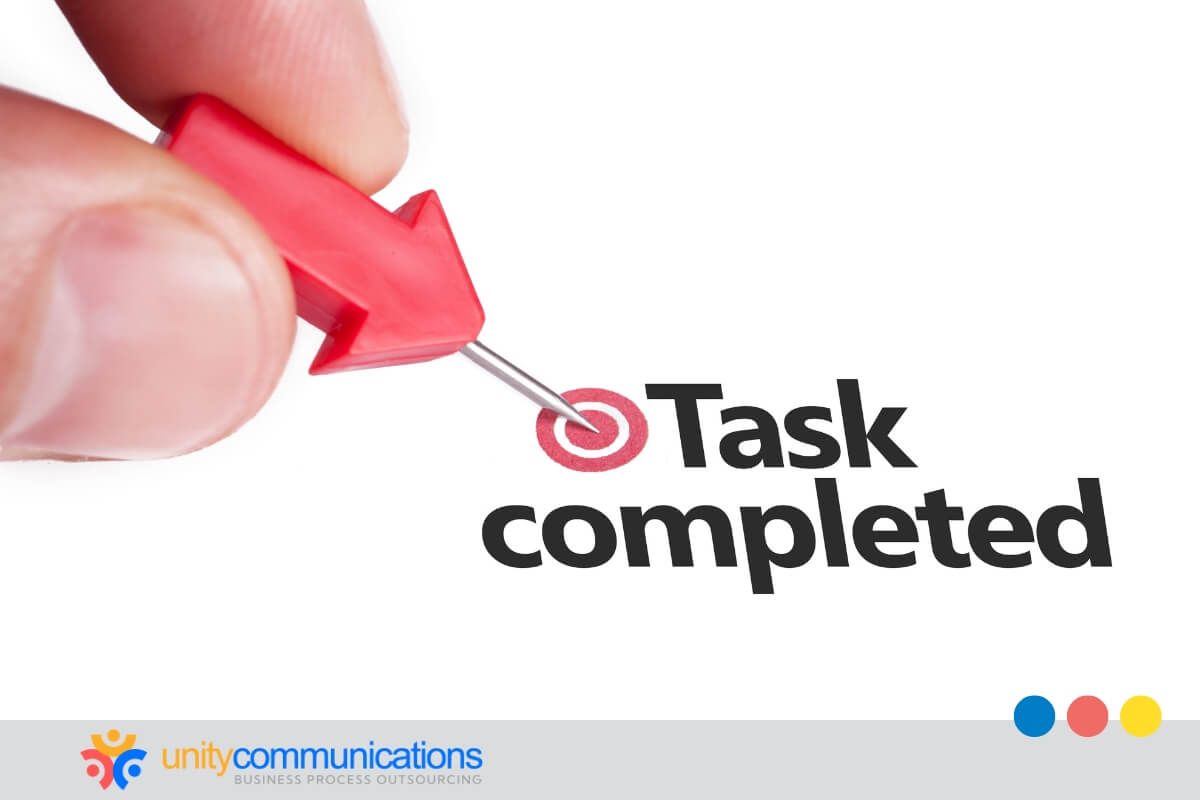Table of Contents
Artificial intelligence (AI) is transforming the way businesses operate by enabling teams to work faster, smarter, and more accurately. One of the most advanced uses of autonomous AI agents is that they can act, make decisions, and adapt with minimal to no supervision.
These innovative systems are transforming business process outsourcing (BPO) and providing small and medium-sized businesses (SMBs) with new opportunities to grow and remain resilient. Learn how they work and what sets them apart from other tools.
What makes an AI agent truly autonomous

What is autonomous AI? It is a system that can make decisions, prioritize tasks, and act without continuous human supervision. Autonomous AI agents help SMBs handle complex workflows, reduce manual oversight, and accelerate operations. Their independence lets you focus on higher-value work while routine processes run smoothly.
The market for AI agents is experiencing rapid growth. Estimates put the value at around $7.92 billion in 2025 and project it to surge past $235 billion by 2034. This dramatic growth indicates that more companies are willing to entrust AI with real responsibilities, and it suggests just how integral these systems could become in everyday business operations.
To understand what an AI agent is, think of it as a digital coworker who doesn’t need coffee breaks. It observes patterns, anticipates needs, and takes action based on defined goals. This might involve sorting through customer requests, flagging urgent issues, or recommending next steps without requiring intervention at every turn.
Autonomous AI systems deliver measurable benefits:
- Faster task completion. Systems handle repetitive or complex work without constant oversight.
- Consistent workflows. Agents maintain accuracy and reliability across multiple processes.
- Operational efficiency. Automation frees human teams to focus on strategy and high-priority work.
- Reduced team dependency. Fewer staff members are required for routine functions, resulting in lower costs and overhead.
These systems function as strategic partners, supporting more intelligent decision-making and streamlining operations. SMBs that adopt them thoughtfully often find their teams can do more with less stress, while AI quietly manages the day-to-day details.
Inside the mind of an autonomous AI system
To understand how autonomous AI agents think, consider how they process information before taking action. They don’t simply react. They interpret the context, weigh the goals, and assess the outcomes before taking action. This structured reasoning helps them manage complex tasks efficiently and consistently.
The field is evolving rapidly. In 2024, nearly 90% of major AI models originated from industry, up from 60% the previous year. This shift highlights a critical trend: companies are now driving AI innovation, prioritizing practical systems that address real business challenges and optimize daily operations.
Different types of AI agents handle reasoning in unique ways. Reactive agents deal with immediate situations. They see a problem and respond immediately. Learning agents, on the other hand, utilize past data to make increasingly informed choices over time. Understanding this difference helps you determine which approach best suits your business.
However, most autonomous AI systems think and act in the following manner:
- Data collection. Pull information from various sources to understand what’s happening
- Analyze context and predict outcomes. Examine trends, risks, and potential next steps.
- Decide and act. Consider multiple options before making a decision.
- Evaluate and refine. Implement the decision, monitor the outcome, and refine it based on the results.
Each cycle builds on the last. These agents continuously learn, combining logic and adaptability to stay sharp and consistent, even under pressure.
How large-language models drive smart decisions
Large-language models (LLMs) sit at the heart of intelligent autonomous systems. They no longer just follow commands. They understand what’s being said, pick up on context, and determine what needs to happen next. For your business, that means quicker insights and more informed decisions without needing to step in all the time.
These models do more than store information. They uncover patterns in data, understand what matters, and act on it, such as speeding up reports, automating responses, and improving daily work.
If you’re an SMB owner exploring outsourcing and efficiency, LLM-powered AI fits naturally into BPO and digital transformation strategies. Consider customer service, data management, or back-office operations, areas where speed and accuracy are crucial. By powering these systems, LLMs streamline workflows, reduce manual errors, and free teams to focus on high-value work.
Here’s how LLMs help businesses:
- Natural language understanding. Interpret and communicate information clearly, improving team interactions with systems, documents, and customers.
- Predictive insights. Analyze real-time and historical data to anticipate trends, identify risks, and recommend actions.
- Automated recommendations. Guide tactical operations and strategic planning while minimizing manual intervention.
- Context-aware actions. Adjust priorities and actions dynamically in response to evolving customer needs and changing business conditions.
Integrating LLMs into daily operations gives autonomous AI agents the intelligence to act independently and accurately across multiple functions. These models help your business think faster, move smarter, and thrive.
When multiple AI agents work together
Multiple autonomous AI systems can collaborate. They divide tasks, share knowledge, and pull together toward shared goals. For SMBs, this type of teamwork boosts outcomes without requiring additional personnel or pressure.
Coordination occurs through the sharing of data and structured communication. Every agent is in sync with the rest. They share updates, adjust priorities as needed, and maintain a balanced workload to ensure effective project management. This coordination prevents bottlenecks from occurring and maintains steady daily operations.
For organizations that rely on outsourcing, this approach fits neatly within the functions of BPO. Multi-agent systems power customer service, data entry, and accounting. They work day and night, minimize errors, and maintain consistent operations.
Multi-agent systems work this way:
- Task division. Assign roles based on strengths.
- Knowledge sharing. Prevent duplication and improve accuracy.
- Dynamic adjustments. Rebalance workloads as priorities shift.
- Parallel performance. Handle multiple operations simultaneously.
Multi-agent collaboration creates a powerful productivity engine that automates coordination, reduces operational friction, and enables teams to focus on strategic, creative initiatives while AI manages routine workflows.
Connecting AI agents with your tools

Integrating autonomous AI agents with existing business tools delivers immediate value. Connections with customer relationship management (CRM) systems, cloud applications, and internal platforms reduce manual effort and ensure seamless data flow. This integration frees leadership to focus on strategy rather than operational maintenance.
Effective integration extends beyond time savings. It enables contextual intelligence. Agents access data across systems, trigger automated actions, and maintain synchronization. When departments operate on unified, real-time data, workflows improve and potential issues are identified before they impact operations.
Strategic outsourcing capabilities expand significantly when AI agents integrate with core business systems. They automate routine tasks, maintain team connectivity, and ensure outsourced operations remain productive with minimal oversight.
Connected AI agents enhance workflows through the following:
- Keep systems in sync. Automatically update CRMs, email tools, and cloud apps without manual input.
- Respond in real time. Trigger follow-ups or alerts whenever customer actions or approvals occur.
- Track progress. Monitor ongoing tasks and flag bottlenecks so teams can adjust quickly.
- Keep records current. Automatically update dashboards, reports, and shared documents.
- Align with service providers. Coordinate with third-party teams to maintain consistency across shared work.
- Adapt to change. Adjust priorities dynamically as projects shift or new data becomes available.
AI agent integration extends beyond workflow automation. It unifies your entire operation. System connectivity reduces errors, increases visibility, and enables teams to concentrate on strategic initiatives that drive growth.
Why autonomous agents outperform traditional AI
Autonomous AI agents stand apart from traditional AI because they think and act in real time. They can decide on the next step, adapt to changes, and manage unclear situations without waiting for constant human direction. This flexibility lets SMBs maintain their performance as conditions shift.
Research indicates that generative AI improves user performance by 66% across three studies. The biggest jumps happen in complex tasks, especially for teams with less experience. This data demonstrates that autonomous agents deliver faster and more intelligent outcomes than standard AI models.
When SMBs weigh outsourcing efficiency, a cost-benefit analysis of outsourcing often leans toward autonomous systems. These agents handle repetitive or data-heavy work, trim costs, and boost output quality. They help teams complete projects more efficiently while maintaining high standards.
Autonomous agents outperform traditional AI by:
- Keeping workflows running smoothly by optimizing without intervention
- Spotting and preventing bottlenecks before they cause slowdowns
- Managing complex, multi-step operations with strong context awareness
- Learning from past results to make smarter decisions next time
- Syncing across tools for quicker, connected responses
- Reducing errors in repetitive, high-volume work
Adopting autonomous agents enables your business to move beyond fixed algorithms. You gain speed, accuracy, and adaptability—technology that keeps up with your goals and strengthens daily operations.
Real business wins from AI adoption
In 2025, an increasing number of companies turned to intelligent technologies to streamline their daily operations. Approximately 78% now use AI in at least one business function, up from 72% in early 2024 and 55% in 2023. The numbers show how autonomous AI agents are becoming essential for efficiency and more innovative workload management.
The results are clear. Your business can save money, respond more quickly, and deliver a stronger service. With AI agents managing repetitive tasks, your teams gain more time to focus on strategy and growth.
For businesses that rely on outsourcing, the BPO advantages grow even further when AI agents streamline processes. These systems handle data-heavy or routine operations, help coordinate across departments, and support third-party teams in maintaining consistent quality and output.
In the process, your business gains:
- Faster response times. Agents automatically handle requests, reducing wait times.
- Lower operating costs. Minimize manual work while maintaining productivity.
- Improved accuracy. Reduce errors and increase confidence in business insights.
- Streamlined workflows. Coordinate multiple functions seamlessly for efficiency.
- Enhanced customer experience. Deliver faster, more relevant interactions.
- Scale operations. Expand capabilities without adding headcount.
As AI agents integrate into daily operations, you experience measurable gains in speed and efficiency. Autonomous AI adoption reduces costs, accelerates service delivery, and increases productivity, maintaining quality standards and operational consistency.
How AI agents keep learning and improving
AI systems don’t stay static. They adapt by analyzing feedback, recognizing new patterns, and refining their operations. Over time, autonomous AI agents become sharper, more reliable, and more aware of context. That adaptability helps your business stay efficient even as needs and conditions shift.
Learning happens continuously. These systems review performance data, identify areas for improvement, and adjust their approach to enhance accuracy and response quality. It’s a quiet but powerful process that consistently increases speed and precision in your operations.
Here’s how continuous learning works:
- Performance monitoring. Track KPIs to identify inefficiencies and optimize workflow bottlenecks.
- Predictive learning. Analyze historical outcomes to anticipate challenges and improve future responses.
- Behavioral adaptation. Align with evolving customer and user patterns to increase accuracy.
- Process optimization. Refine repetitive workflows using adaptive algorithms to ensure consistent output quality.
- Real-time intelligence. Enable data-driven decisions through continuous analysis and actionable insights.
- Cross-system integration. Synthesize inputs from multiple sources for enhanced contextual decision-making.
With each iteration, system intelligence increases. Agents identify anomalies, implement corrections, and enable teams to focus on strategic innovation, allowing continuous improvement to occur autonomously.
As your business expands, your AI agents grow with it. They continually learn, adjust, and refine their processes, allowing you to spend less time fixing mistakes and more time keeping everything running smoothly.
The real risks behind autonomous AI systems

Autonomous AI agents offer efficiency but carry real risks that you must recognize. Biases in decision-making, gaps in data security, and operational vulnerabilities can affect outcomes. Understanding these threats helps you to manage automation responsibly, protecting your business and customers.
Common risks include:
- Data security breaches. Unsecured systems or integrations might expose sensitive client and organizational data to unauthorized access.
- Algorithmic bias. Training data biases can lead to discriminatory outputs that compromise decision fairness and stakeholder trust.
- System errors. Technical failures or glitches can disrupt workflows, delay operations, or result in inaccurate outputs.
- Lack of transparency. Limited visibility into AI reasoning processes can hinder audits, accountability, and regulatory compliance.
- Overreliance on automation. Excessive automation dependency might reduce critical human oversight and delay error detection.
- Compliance issues. Failure to meet industry standards can result in legal liability, financial penalties, and reputational damage.
Awareness of BPO risks and drawbacks is crucial when integrating autonomous AI into outsourced operations. Weak controls, unclear roles, or system failures can pose real dangers. The key is to catch them early and avoid losses, keeping service running smoothly.
Proactive risk management encompasses regular audits, robust access controls, and continuous monitoring of AI outputs for any unexpected patterns. Combining human oversight with automated checks reduces exposure and maintains trust in your systems.
When you spot vulnerabilities early, you can align your AI agents with company standards and security rules. Automation fuels growth while keeping your data safe and your customers’ trust intact.
What’s next for autonomous agents
AI platforms are rapidly becoming an increasingly integral part of daily business. They analyze data, guide strategy, and connect teams across functions. For SMBs, that means faster action and more intelligent decisions.
Emerging use cases include:
- Market intelligence. Analyze consumer behavior and emerging patterns to anticipate demand.
- Automated decision-making. Handle routine operational decisions across departments autonomously, reducing latency and error rates.
- Project orchestration. Assign tasks, track progress, and balance department workloads.
- Strategic scenario modeling. Enable leaders to evaluate options and prepare for potential outcomes.
- Real-time performance optimization. Continuously monitor operational metrics and adjust processes dynamically to maintain targets.
Research found that 49% of CEOs think AI might replace and automate their duties. That shift reflects growing confidence in AI’s ability to guide decisions at strategic levels. For SMBs, leaning into this change supports resilience and intelligent growth.
Integrating autonomous AI agents more deeply into your operations extends automation beyond isolated workflows. These tools predict outcomes, advising you on the next steps to take. They simplify reports, spot performance gaps, and free your team to focus on more valuable work.
As automation gets smarter, balance really matters. Let AI agents handle more tasks, but keep people in charge of key decisions. That’s how you scale responsibly and stay relevant.
How autonomous AI agents transform outsourcing
Autonomous AI agents are rewriting the rules of outsourcing. They handle repetitive work, keep workflows running smoothly, and help SMBs move faster while spending less. They deliver accuracy and consistency without constant oversight.
The global BPO market size was valued at $302.62 billion in 2024 and is expected to reach $525.23 billion by 2030. This growth demonstrates increasing reliance on intelligent systems for outsourced work, showing how self-operating AI tools can support broader business objectives while keeping operations lean.
Integrating AI into outsourcing strategies allows your team to understand what BPO is and how its services can be enhanced. Automation meets traditional workflows—operations flow better, and visibility improves.
Practical applications include:
- Customer support optimization. AI handles inquiries, ticket routing, and follow-ups for faster resolution.
- Data processing accuracy. Reduce errors in high-volume administrative tasks.
- Back-office coordination. Align teams and resources efficiently across departments to optimize productivity.
- Service-level agreement (SLA) compliance monitoring. Ensure contracted service standards are met consistently.
- Process improvement intelligence: Provide actionable insights to improve operations.
Through AI and BPO, you can modernize operations and make your partnership with a third-party provider more strategic. Understanding how outsourcing works helps you identify which processes benefit most from AI integration. Using autonomous systems in these areas reduces errors, improves response times, and lets your team focus on higher-value priorities.
Additionally, adopting self-operating AI tools in BPO operations positions your business to scale efficiently, minimize manual overhead, and maintain high-quality service levels in a dynamic market.
The bottom line
Autonomous AI agents deliver measurable improvements in speed, accuracy, and scalability across critical business functions, from customer service to back-office operations.
By combining strategic outsourcing with AI automation, you can scale smarter, adapt faster, and free your teams to focus on innovation.
Ready to see how AI can streamline your operations? Let’s connect and explore how autonomous agents can help your business grow.




